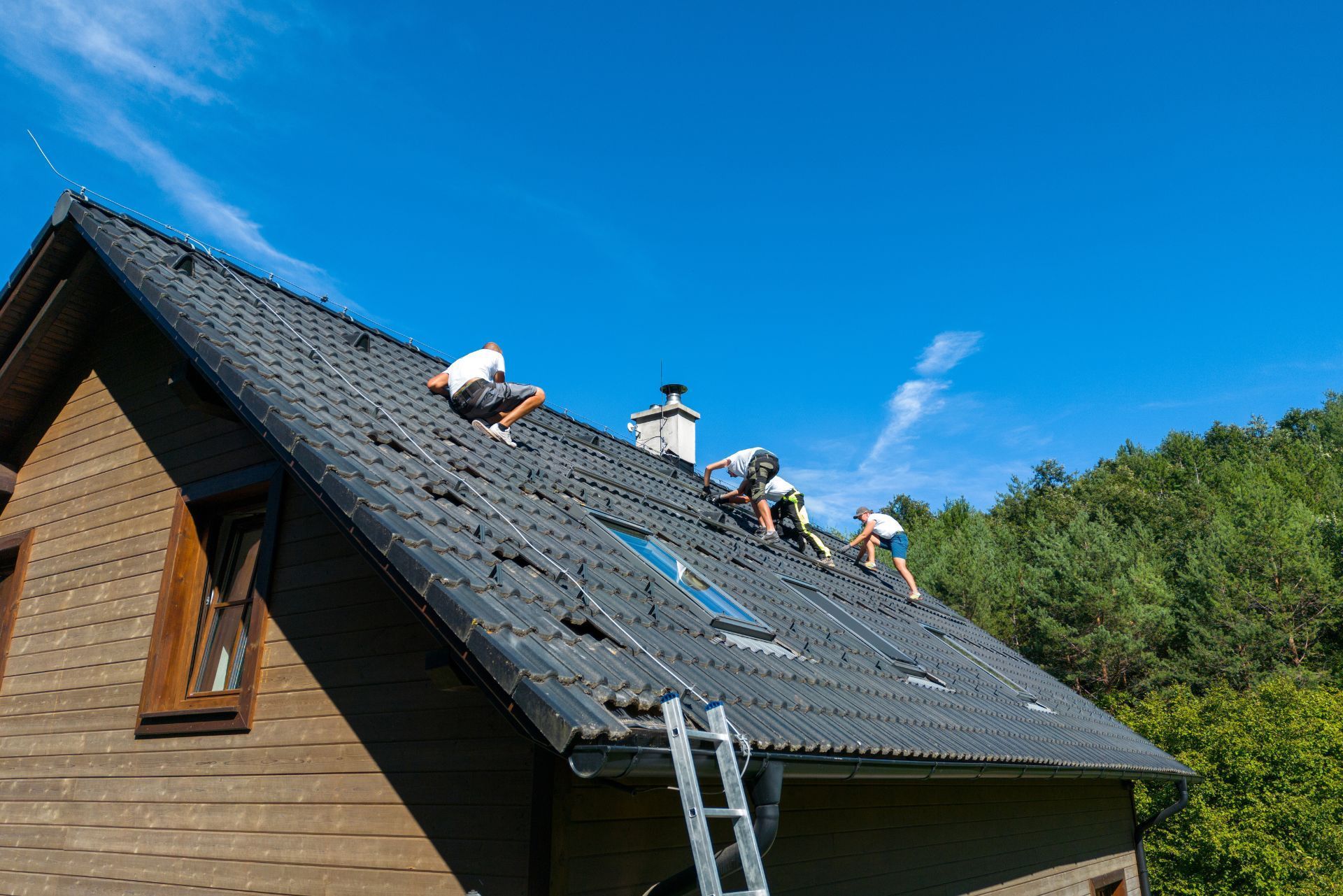Maryland Roofing Contractors Insurance
See How We're Different:
Call Us: 202-223-1506
Top 3 Recommended Business Policies
Index
Contact Us
Roofing is a high-stakes job. Every day, contractors face risks that go beyond the usual construction hazards. From precarious heights to unpredictable weather and complex tools, the dangers are real and constant. That’s why understanding what general liability (GL), workers’ compensation (comp), and height limits mean in Maryland is crucial for anyone in the roofing business. Getting these details right isn’t just about compliance-it’s about protecting your crew, your business, and your bottom line.
Maryland recently raised the bar on insurance requirements for home improvement contractors, including roofers. Starting June 1, 2024, licensed contractors must carry $500,000 in general liability insurance, a significant jump from the previous $50,000 minimum. This change reflects the high-risk nature of roofing and the need for stronger financial safeguards. For more on these new rules, you can visit the Allen Thomas Group’s update on Maryland contractor insurance.
Why General Liability Insurance Matters for Maryland Roofers
General liability insurance is the backbone of any roofing contractor’s risk management plan. It covers claims related to property damage, bodily injury, and legal defense costs if a third party sues. For roofers, this could mean anything from a homeowner slipping on debris to damage caused by falling tools.
Maryland’s new $500,000 minimum requirement for licensed contractors reflects the reality that roofing jobs can lead to costly claims. Previously, the $50,000 threshold was often insufficient to cover serious incidents. Now, with the higher limit, contractors have a better safety net to handle claims without risking bankruptcy.
Typical policies for Maryland roofers range from $800 to $3,000 annually for $1 million per occurrence and $2 million aggregate limits. These figures vary based on factors like company size, claims history, and specific job risks. Keep in mind that roofing is considered one of the highest-risk construction activities, so insurers price policies accordingly. For a detailed look at roofing risks and insurance needs, see the Contractors Choice Agency Blog.
Understanding Policy Exclusions
Not all general liability policies are created equal. Some include endorsements or exclusions that can catch roofers off guard. For example, a notable 2016 court case, Essex Insurance Company v. Y&J Construction Inc., highlighted how roofing endorsements excluded coverage for operations involving hot tar, open flames, or heat applications. This means if your work involves these materials or methods, your standard GL policy might not cover related claims.
Roofers should carefully review their policies and discuss any exclusions with their insurance agent. Adding specific endorsements or separate coverage for high-risk operations can prevent costly gaps. Understanding these nuances can save a business from unexpected out-of-pocket expenses.
In addition to the financial protection that general liability insurance provides, it also plays a crucial role in establishing credibility with clients. Homeowners often seek proof of insurance before hiring a contractor, viewing it as a sign of professionalism and reliability. By maintaining adequate insurance coverage, roofers can not only protect their business but also enhance their reputation in a competitive market. Furthermore, many clients may require proof of insurance as part of the contract, making it essential for roofers to have their documentation in order before starting any project.
Moreover, the complexities of roofing projects often lead to unforeseen circumstances, such as inclement weather or material defects, which can exacerbate risks. Having a robust general liability policy can help mitigate the financial fallout from these situations. For instance, if a storm damages a partially completed roof, the contractor could face claims from both the homeowner and subcontractors. In such scenarios, having comprehensive insurance coverage ensures that the contractor can address these claims without jeopardizing their financial stability or project timelines.

Workers’ Compensation Insurance: Protecting Your Crew and Your Business
Roofing is physically demanding and dangerous. Falls, tool accidents, and weather exposure are daily threats. Maryland requires all roofing contractors to carry workers’ compensation insurance for every employee. This coverage pays medical bills and lost wages if a worker gets injured on the job.
The average cost for workers’ comp insurance in Maryland is around $3,776 annually per employee. This might seem steep, but it’s a necessary expense to protect both workers and the company. Without it, injury claims could lead to lawsuits and severe financial consequences.
Since roofing ranks among the highest-risk construction activities according to OSHA, insurers expect higher premiums. Maryland roofers typically pay between $2,000 and $5,000 annually for insurance, reflecting the elevated risk of worker injuries. For more on workers’ compensation costs and requirements, check out the Allen Thomas Group’s overview of Maryland contractor insurance and Roof Solutions’ insights on roofing insurance premiums.
Why Workers’ Compensation is Non-Negotiable
Without workers’ comp, roofing contractors risk lawsuits from injured employees, which can be financially devastating. It also protects the business from regulatory penalties. Maryland enforces these requirements strictly, so skipping coverage is not an option.
Investing in workers’ compensation insurance also helps attract and retain skilled workers who want assurance their safety and health are prioritized. It’s a sign of professionalism and responsibility in a tough industry. Moreover, many clients now demand proof of coverage before awarding contracts, as they want assurance that the contractors they hire are committed to safety and compliance. This not only enhances your reputation but also opens doors to more lucrative projects that may otherwise be out of reach.
Additionally, having robust workers’ compensation insurance can foster a positive workplace culture. When employees know that their well-being is a priority, they are likely to feel more valued and motivated. This can lead to increased productivity and lower turnover rates, which ultimately benefits the business's bottom line. Furthermore, many insurance providers offer resources and training programs aimed at reducing workplace accidents, which can further enhance safety protocols and minimize claims over time.
Height Limits and Their Impact on Insurance and Safety
Roofing work inherently involves heights, which brings a unique set of hazards. Falls from roofs are among the leading causes of injuries and fatalities in construction. Insurance companies and regulators pay close attention to height limits because the risk increases dramatically as elevation rises.
While Maryland does not specify a universal height limit for roofing insurance, the risk profile of projects involving steep or high roofs influences premiums and coverage terms. Roofers working on taller structures may face higher insurance costs or stricter safety requirements.
Safety protocols such as fall protection systems, guardrails, and proper training become essential not only for worker safety but also to satisfy insurer conditions. Roofers who neglect these measures might see their premiums spike or even face denial of coverage.
How Height Influences Insurance Costs
Insurance providers assess the risk of injury based on job site conditions, including height. The higher the roof, the greater the potential severity of a fall. This risk translates into higher premiums for both general liability and workers’ compensation policies.
Contractors should keep detailed records of safety training and equipment use to demonstrate risk management efforts. This can help negotiate better rates and avoid coverage issues. For a deeper dive into roofing risks and insurance, the Contractors Choice Agency Blog offers valuable insights.
Moreover, the geographical location of a roofing project can also play a significant role in determining insurance costs. Areas prone to severe weather conditions, such as high winds, heavy snowfall, or frequent storms, can increase the risk of accidents or damage, leading to higher premiums. Insurers may require additional safety measures or specialized training for workers to mitigate these risks, further impacting the overall cost of coverage. Understanding these regional factors can help contractors better prepare for the financial implications of their projects.
Additionally, the type of roofing material used can influence insurance rates as well. Certain materials may require specific handling or installation techniques that could pose additional risks. For instance, working with slate or tile roofs may necessitate more advanced safety measures compared to traditional asphalt shingles. By being aware of these nuances, contractors can make informed decisions about the materials they choose, which can ultimately affect their insurance premiums and the safety of their workforce.
Balancing Coverage Limits with Business Needs
Choosing the right coverage limits is a balancing act. Too little insurance leaves you exposed to financial ruin. Too much can strain cash flow with unnecessary premiums. Maryland’s updated $500,000 general liability minimum sets a solid baseline, but many contractors opt for higher limits to match the scale of their projects.
For example, policies offering $1 million per occurrence and $2 million aggregate limits are common in Maryland. These limits provide broader protection against multiple claims or large single incidents. Workers’ compensation coverage should also align with the size of your crew and the nature of your work. Understanding the specific risks associated with different types of roofing projects—such as exposure to hazardous materials or the potential for accidents on steep slopes—can help you determine the most appropriate coverage levels. Additionally, seasonal fluctuations in work volume may necessitate adjustments in your insurance to ensure adequate protection throughout the year.
Consulting with an insurance professional familiar with Maryland roofing can help tailor a package that fits your risk profile and budget. Remember, the cheapest policy isn’t always the best if it leaves gaps in coverage. An expert can also guide you through endorsements or additional coverages that may be beneficial, such as equipment breakdown or professional liability insurance, which can safeguard against errors in design or installation that lead to costly claims.
What Happens When Limits Are Too Low?
If a claim exceeds your policy limits, you’re responsible for the difference. This can mean paying out of pocket for medical bills, legal fees, or property damage. Such expenses can quickly drain business resources and threaten survival. The financial implications of underinsurance can be particularly severe in the roofing industry, where the cost of materials and labor can escalate rapidly in the event of a mishap.
Maryland’s tenfold increase in minimum GL coverage reflects these realities. It’s a wake-up call for contractors to reassess their insurance and ensure it matches the risks they face daily on the job. Moreover, as the industry evolves with new technologies and materials, the nature of risks also changes. For instance, the increasing use of eco-friendly materials and advanced installation techniques may introduce new liabilities that traditional policies do not cover. Staying informed about these trends and regularly reviewing your coverage can help you adapt and protect your business effectively in an ever-changing landscape.

Final Thoughts on Insurance for Maryland Roofing Contractors
Roofing is a demanding trade with risks that require serious insurance protection. Maryland’s updated requirements for general liability and workers’ compensation insurance underscore the importance of adequate coverage. Understanding what GL, comp, and height limits mean in practical terms helps contractors make informed decisions that protect their workers and their businesses.
Insurance is not just a regulatory box to check. It’s a vital tool to manage risk, safeguard livelihoods, and maintain professional credibility. Staying informed about policy details, exclusions, and state mandates ensures you’re not caught off guard when accidents happen. The nuances of insurance policies can be complex, and it’s essential for contractors to engage with knowledgeable agents who can clarify the fine print and help tailor coverage to specific operational needs. This proactive approach can prevent costly gaps in coverage that might arise from misinterpretations or overlooked details.
For Maryland roofing contractors, investing in the right insurance coverage is an investment in stability and peace of mind. Additionally, it fosters trust with clients, who often seek reassurance that their contractors are adequately insured. A well-structured insurance policy not only protects the contractor but also enhances their reputation in a competitive market. By showcasing comprehensive coverage, contractors can differentiate themselves, potentially leading to more business opportunities and long-term client relationships. Learn more about how to protect your business by exploring resources like the Allen Thomas Group’s contractor insurance guide.
Frequently Asked Questions
Q: What is the new minimum general liability insurance requirement for Maryland roofing contractors?
A: As of June 1, 2024, Maryland requires licensed contractors to carry at least $500,000 in general liability insurance, up from $50,000. This significant increase reflects the state's commitment to ensuring that contractors are adequately protected against potential liabilities that can arise during roofing projects. The higher requirement aims to safeguard both consumers and contractors by ensuring that there are sufficient funds available to cover claims that may arise from accidents or damages during the course of work.
Q: Why is workers’ compensation insurance important for roofing contractors in Maryland?
Workers’ comp covers medical expenses and lost wages for employees injured on the job. It is mandatory in Maryland and protects both workers and the business from lawsuits. This insurance is particularly crucial in the roofing industry, where the risk of falls and other accidents is heightened due to the nature of the work. By having workers' compensation insurance, roofing contractors not only comply with legal requirements but also foster a safer work environment, which can improve employee morale and retention.
Q: How do height limits affect roofing insurance premiums?
Higher roofing jobs carry greater fall risks, which can increase insurance premiums and require stricter safety measures to maintain coverage. Insurers often assess the height of roofing projects when determining premiums, as jobs at greater elevations pose more significant risks for accidents. This can lead to additional training requirements for workers and the implementation of enhanced safety protocols, such as harness systems and safety nets, to mitigate these risks and potentially lower insurance costs over time.
Q: Can general liability insurance exclude certain roofing operations?
Yes. Some policies exclude coverage for specific activities like hot tar or open flame work, so contractors should review policy details carefully. This exclusion can leave contractors vulnerable during certain types of projects, making it essential for them to fully understand their coverage. Additionally, contractors may need to seek specialized insurance policies or endorsements to ensure they are protected against the unique risks associated with these high-risk operations.
Q: What are typical annual costs for roofing insurance in Maryland?
General liability insurance ranges from $800 to $3,000, while workers’ compensation averages about $3,776 per employee annually, with total roofing insurance costs often between $2,000 and $5,000 per year. These costs can vary significantly based on factors such as the size of the company, the scope of work, and the contractor’s claims history. Contractors should shop around for quotes and consider bundling policies to potentially reduce overall expenses.
Q: What risks does general liability insurance cover for roofers?
It covers third-party claims for property damage, bodily injury, and legal defense costs related to roofing operations. This can include incidents where a passerby is injured by falling debris or if a roof installation causes damage to a neighboring property. By having this coverage, roofing contractors can protect their business from the financial repercussions of such claims, allowing them to focus on their work without the constant worry of potential lawsuits. Furthermore, having robust insurance can enhance a contractor's reputation, as clients often prefer to hire insured professionals for peace of mind.

